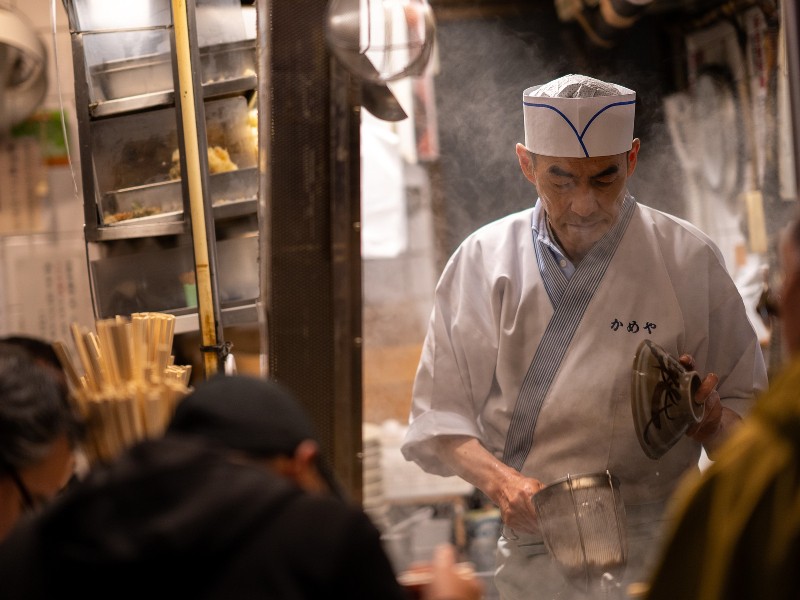One of Japan’s biggest draws as a holiday destination is its amazing gourmet scene. It really is hard to have a bad meal in Japan, and since moving here I definitely got spoiled with so much great food to be enjoyed. Generally, quality is more important than quantity in Japanese food, and food is often beautifully presented. There are many Michelin-starred restaurants in Japan, but now I’d like to introduce you to my personal favorite street food you should try when you come to Japan.
Most Popular Street Food in Japan
Many articles about street food in Japan already listed the same 3 must-try street foods, so let’s get those out of the way first! The foods that keep coming back on every list are takoyaki, yakisoba, and okonomiyaki. That’s a lot of yaki, which makes sense, as ‘yaki’ means ‘baked’ or ‘fried’. And who doesn’t like fried foods?

Takoyaki are little dough balls with octopus inside. Yakisoba are fried noodles with a bit of meat and pink ginger. And Okonomiyaki is a Japanese savory pancake with lots of cabbage and usually pork with copious amounts of batter. While I can vouch for all 3 dishes, I usually like to eat some of the slightly less common types of street food. Here they are!
Yakiimo
This is by far the healthiest option of the street foods listed here; grilled sweet potato. It is a very simple but delicious dish that contains many nutritious vitamins and minerals such as vitamin A, C, and manganese. There are no ingredients added when baking the potato, it’s just the potato’s good natural taste. Japanese people have been eating sweet potatoes since the early Edo period, and they have kept many people alive during WW2.

There are 4 types of sweet potatoes; Satsuma, Annou, Milk Sweet, and the Okinawan Beni Haruka. The Satsuma potato is the most common type. Yakiimo are usually sold by tiny food trucks in busy shopping and nightlife districts. The best season for sweet potatoes is autumn, and you can find them easiest during the colder months.
Gyoza
There aren’t many foods that pair better with beer than the delectable gyoza. These dumplings filled with very flavorful ground meat pack a punch in the flavor department. In this way, they are unlike most Japanese food which tends to have less strong flavors. This makes sense, as the origins of gyoza are Chinese. To finish it off, you dip them into a mixture of soy sauce and vinegar for a hint of sour.
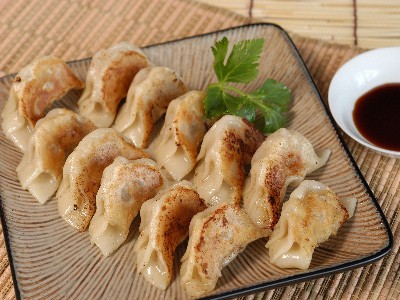
Gyoza are originally from China, but they have been enjoyed in Japan for centuries. They became especially popular in the 20th century when chain restaurants serving gyoza started popping up. Nowadays, Utsunomiya and Hamamatsu are cities that are especially known for their gyoza. If you want to try funky new varieties with shrimp, mushroom, or cheese fillings, taking a trip to one of those cities is a great idea.
Dango
If you are familiar with Japanese anime, you have probably seen characters eat colorful little balls on a stick. These rice cake balls are called dango, and they are a very popular treat for young and old. The most common dango is the mitarashi dango as seen in the picture. These are dango glazed with sweet soy sauce that have a unique sweet-salty flavor. As long as you are mentally prepared for something that’s not only sweet, I think that mitarashi dango are very tasty.
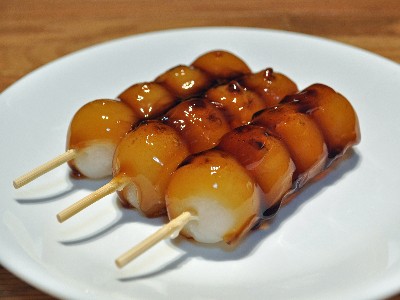
There are many kinds of dango, and the sanshoku dango is the most colorful type. These dango are pink, white, and green. The green ball is made with yomogi, a type of leaf, which gives it a slightly different flavor. But my absolute favorite dango are the fancy ones with creamy fruit sauce on top. They have all kinds of flavors such as sakura, strawberry, green tea, red beans, and more. The toppings give the rice cake juiciness that the regular ones don’t have.
Fresh Senbei
In many countries, you can buy small Japanese rice crackers, but there is nothing like the freshly-made ones. More traditional areas like Asakusa in Tokyo often have spots where they are baking senbei. The recipe is quite simple, the crackers are made with rice flour and while they are baking, they are brushed with a mixture of soy sauce and sake. You can eat them like that, or you can go decadent and have a crispy piece of nori seaweed added.
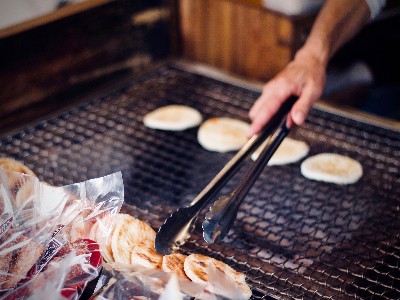
There are other types of senbei as well, such as sesame, spicy, shrimp, and sugar senbei. These are usually not baked fresh though, so personally, I prefer the plain freshly baked senbei with a sheet of seaweed.
Kushikatsu
Coming from Japan’s street food capital Osaka, kushi means ‘skewers’, while katsu means ‘deep fried meat’. So you can guess what type of street food kushikatsu is! Osaka’s Shinsekai first served in the 1920s it to laborers, and her fried meat skewers became very popular. Osaka’s version has only one type of meat on each skewer, but kushikatsu in other regions can have different combinations.
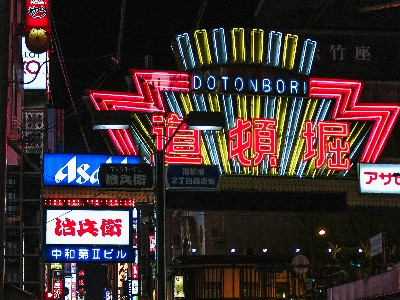
Kushikatsu has many slightly different versions in Japan’s larger cities outside of Osaka like Nagoya, Kobe, and Tokyo. The variation is usually in the batter and sauces that are used. One of the most variations is from Nagoya where they love their red miso. Here, you will dip your fried meat stick into a pot with thick grilled beef sauce with a miso base.
Onigiri
This street food can also be eaten without too much guilty feelings afterward, although that depends a little bit on the filling. Originally made for its convenience for eating on the go, onigiri‘s history goes way back. Already in the Heian period, they ate rice made into a shape that made it easy to eat without chopsticks. Samurai even had rice balls wrapped in bamboo to have something to eat quickly during the war. And nowadays salarymen eat them as a quick bite from convenience stores.

But the onigiri that you should really try are not for sale in convenience stores. They are the ones that are sold in small onigiri specialty stores. You can find them in larger stations and in some shopping streets. I still crave the bonito-cheese and tuna-mayo onigiri from a franchise called Nigiritate. They only have shops in Chubu (around Nagoya), so if you happen to be in that area don’t forget to have one of their delicious freshly-made onigiri! The spam onigiri you see in the picture is also highly recommended.
Where to Eat Street Food in Japan
Street food is not as common in Japan as it is in many southeast Asian countries. Western tourists often got exposed to popular street food cultures in Thailand or Vietnam, but the Japanese version is somewhat subdued. First of all, eating and walking at the same time is frowned upon. Also, there are so many small, half-open restaurants that serving street food seems a bit superfluous in many areas.
There are two main area types to eat street food in Japan. First of all, there are dedicated food markets that are famous for street food. In Tokyo, you can for example go to Sunamachi Ginza, Ameya Yokocho, or Tsukiji. In Osaka, you should head to Dotonbori or the Kuromon market. Another way is to go to festivals, or matsuri. Street food is a large part of festival culture in Japan, and you will find all our favorite foods such as yakisoba, dango, and okonomiyaki.
Your Japan Tour
As seasoned Japan experts, we create perfect Japan package tours including carefully selected local specialty foods. Check out our group tours and private tours, or contact us to start planning your unforgettable holiday to this fascinating country full of once-in-a-lifetime experiences, culture, history, nature, and delicious food!
